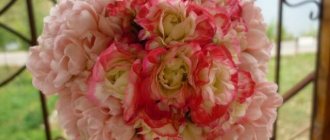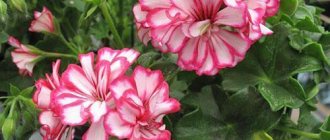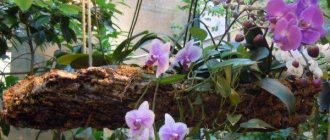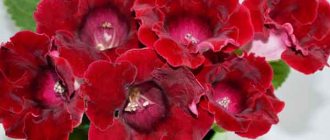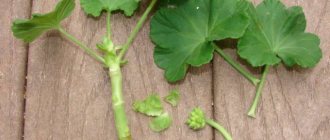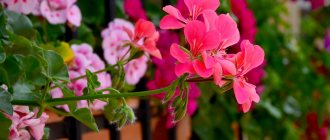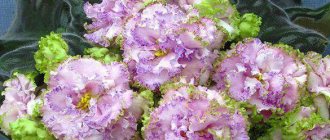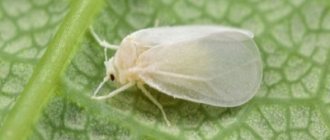Decorative use
Sometimes Viva Carolina is used in landscape design.
In this case, a low bush is placed in the foreground or middle ground. In home and artificial (insulated) flower beds, the plant looks great in hanging pots, in pots and flowerpots on the ground and on stands. Flowers look perfect on a windowsill or cabinet and do not need company due to their brightness and originality. However, the plant will play beautifully surrounded by crimson and lilac-blue inflorescences of other plants.
Lush Carolina pelargonium will delight you almost all year round
Anyone who wants to bring airy lightness and lush solemnity to their flower garden should have at least one of the beautiful Viva geraniums, and it will delight you with its charm every day.
Description
Pelargonium Pak (PAC) are hybrid plant varieties distinguished by their magnificent appearance and unique decorative qualities. The varieties are among the most popular today, which is not surprising: along with the stunning external effectiveness of Pak pelargonium, they are also unpretentious in care and grow well even with novice flower growers.
On a note. The cost of a rooted cutting of one of the Pak varieties today is about 500 rubles.
This hybrid is not propagated by seeds at home, since often the plants in this case do not inherit valuable parental qualities. Note that pelargonium Pak is a new word in floriculture, and the varieties were created quite recently.
However, at the very first exhibition, these plants immediately attracted all the attention and immediately earned universal recognition and love. These varieties are intended for landscape gardening, therefore they are distinguished by their unpretentious “character” and are able to withstand rather harsh external conditions.
Planting, propagation and further care
Viva Carolina pelargonium is planted in neutral soil; it is unpretentious to the composition of the soil; a standard garden mixture is suitable. It is recommended to fertilize with complex fertilizer 2 times a month.
The plant does not need frequent watering; it is enough to keep the earthen ball moist and not flood the roots. The ivy plant normally tolerates periodic spraying of the leaves to remove dust.
On a note! You should not keep the pot in the sun so that the inflorescences and leaves do not dry out and turn yellow ahead of time.
Pelargonium Carolina bushes well on its own, but to make the plant more fluffy and achieve a spherical bush, you can pinch and trim the shoots.
Pelargonium Viva Carolina is propagated by cuttings. First you need to root the material. At home, you can place the cuttings in a pot at the end of February. In open ground, this is done after the frosts have ended and the soil has completely warmed up.
Important! The plant does not like heat and drought. Plant or display the flower in partial shade, water moderately
In winter, watering is reduced, except in cases with artificial lighting.
Where and how to plant?
The plant should be planted in a pot with good drainage ; you also need to regularly replant the plant as it grows into pots with a larger diameter.
Lighting and location
Pelargonium does not like direct rays, but at the same time it needs enough sunlight and light.
If you put it in a shady place, the leaves will begin to dry out and the plant will not bloom regularly. The place where the pot stands should not be in drafts or near heating devices, this will lead to temperature changes that the plant can tolerate quite problematically.
Soil requirements
Pelargoniums love neutral soil , which can be purchased ready-made at a specialty store. Or you can prepare it yourself by mixing sand and peat in equal proportions. The soil in the pot must be renewed every three years. Despite how regularly mineral fertilizers are applied, the land is depleted during this time.
Features of care
Let's get acquainted with the main points for caring for this beautiful pelargonium.
Watering
Millfield rose needs regular watering, but without waterlogging the soil. However, overdrying the earthen clod is also undesirable, since in this case the leaves of the plant fall off, which greatly reduces its decorative value.
Overmoistening is unacceptable, since the roots may rot due to waterlogging; in this case, it is usually impossible to save the plant. It is recommended to water the flower when the soil on top dries out, and in winter the frequency of watering must be significantly reduced.
Water for watering this pelargonium should be soft (settled) and at room temperature. Watering with cold water can cause the plant's roots to rot, so it's best to avoid this.
Note! The plant should not be sprayed, but it is necessary to wipe the dust from the leaves from time to time.
Use a slightly damp cloth for this procedure and immediately dry the flower well in sunlight.
Top dressing
In order for Millfield rose to bloom luxuriantly for a long time, the plant requires additional nutrition.
It is recommended to apply fertilizers carefully - it is better not to add any microelements than to overdo it in this case
In the spring, Millfield rose will gratefully respond to nitrogenous fertilizing, and thanks to it will form lush, bright foliage. Before flowering begins, it is necessary to stop using nitrogen and switch to fertilizing with potassium and phosphorus. This change in “diet” will allow the plant to form abundant inflorescences.
Use specialized complex mineral formulations sold in stores to feed pelargonium. The components in these complexes have already been optimally selected. Note that in winter, Millfield rose pelargonium does not need additional nutrition.
Trimming
In order for the bush to form dense and compact, Millfield rose pelargonium needs to be periodically pruned. The procedure promotes lush flowering of the plant, maintains its neat shape, and rejuvenates it.
It is necessary to monitor the elongated shoots throughout the growing season, and with the arrival of autumn it is recommended to carry out anti-aging pruning. The last procedure involves removing all old, dried and diseased branches.
Wintering
Pelargonium Millfield rose in winter must be given a period of rest, during which the flower should be watered extremely rarely and not fertilized.
The dormant period lasts from approximately November to February: as soon as daylight hours lengthen significantly, the plant will begin to wake up. In winter, it is necessary to keep pelargonium at a reduced air temperature (+12-15 degrees), since it is the moderate temperature that allows the plant to form many lush buds.
Note that in winter, the decorative value of Millfield rose pelargonium is greatly reduced, but you should not be afraid of this. A bare stem, a lack of flowers, a small amount of withered foliage: all this will become luxurious and lush again as soon as the growing season begins in the spring.
Pelargonium varieties
Pelargoniums attract with their unpretentiousness, growth rate and hundreds of different beautiful varieties. These are mainly indoor flowers, but in summer they are often planted in flower beds.
Classification The following species are usually grown from varietal pelargoniums:
- zonal;
- fragrant;
- ivy-leaved;
- royal.
Among collectors there are the newest groups, bred on the basis of zonal varieties, which number up to 75 thousand varieties:
- delightful rose-shaped pelargoniums or rosebuds;
- original pelargoniums stellar or star-shaped;
- cactus-like;
- tulip;
- Formosa;
- deacons (deacons).
Flowers are also distinguished by the number of petals (simple, semi-double, double) and the height of the bush (regular and dwarf).
Pelargoniums attract with their unpretentiousness
TOP 10 popular varieties of pelargonium
- A charming 2-color variety Candy Flowers Bicolor (Cambi) with soft pink petals with a bright crimson island in the center. This early flowering series was created in Germany by Elsner Pac based on the Grandiflora pelargonium. Unlike luxurious large-flowered geraniums, which need to be provided with a cool winter without watering for 2 months, the Candy group continues to bloom in winter in heated apartments at temperatures up to 25°C. In summer, flowers are placed in fresh air in pots under cover from rain and wind. Watering is systematic, in hot weather up to 2 times a day.
- The Happy appleblossom variety, like most other zonal rose-shaped plants, has a stem that grows up to 25 cm. It is recommended to grow rosebuds in wide pots, but not deep ones.
- Pelargonium varieties Viva Madeleine (Viva Madeleine) and its other “friends” from the PAK company are distinguished by their stockiness, abundant branching, and long-term flowering of large “roses” on strong peduncles. Pelargonium Pac Viva Madeleine is valued for its delicate and abundant flowering on a neat bush.
- The PAK Salmon queen variety has luxurious and dense inflorescences. Representatives of the series winter well in a warm, bright room - up to 25 °C. In spring, the compact bush of pelargonium Pac Salmon Queen is transformed, almost completely covered with inflorescences of exquisite royal color: white petals with a delicate salmon center.
- Tulip-shaped Emma pleases gardeners with its delicate peach-pink color and graceful flower shape. Emma, according to collectors, is very capricious, although people fall in love with her at first sight.
- The Kronprincesse Mary variety has impressive snow-white tiaras up to 10 cm. Crown Princess Mary is a pink pelargonium, collection 2006, with tight inflorescences on a dwarf bush. With comprehensive fertilizing and constantly slightly moist soil, the flower will decorate a sunny flowerbed until autumn. After pinching, the Kronprinsesse Mary pelargonium bush takes the given shape well.
- One of the beauties of the American dwarf series of recent years is Bold Ann. The variety is low, blooms profusely in shades of a mixture of pink, salmon and white. Bold Ann shoots flower stalks to the sides, forming a rounded silhouette of the bush.
- Star Vectis snow flaunts graceful snowy inflorescences with a greenish center on slender peduncles. The dwarf variety has light green five-fingered leaves with a darker zone along the edges.
- Dove Point inflorescences are distinguished by edged petals. In some varieties, exposure to sunlight causes a slight change in the color of the petals. Dovepoint's voluminous hats turn from white to pink. Therefore, it is better not to place the pots in the sun. Pelargonium Dovepoint touches with dense large inflorescences on low peduncles.
- The light pink Star of the Moscow Region of domestic selection is attractive with its simple elegant flowers. The hybrid is resistant to weather changes, created for growing in flower beds in central Russia. Rises up to 30-40 cm.
Additional Information. Pelargoniums are planted in small pots so that the plants do not fatten, growing green mass, but produce flower stalks.
Candy Flowers Bicolor (Cambi)
Luxurious royal pelargoniums
Keen flower growers tend to the royal, or Grandiflora, pelargoniums, with huge, colorful flowers that give rise to the appearance of miniature Angels. The flowers of royal geraniums are up to 5 cm in diameter and resemble petunias.
Rosebuds
Among double rosebuds, the group with delicately colored petals Happy appleblossom rosebud, really like the color of an apple tree, became famous: Ungarik appleblossom, Westdale appleblossom, Exotica appleblossom (Exotica appleblossom).
The rosebuds include the deep pink Noel Gordon and Saxdalens Selma. The latter variety is found simply under the name Selma. Semi-double flowers of pelargonium Saxdalens Selma amaze with iridescent pure pink shades with a light underside of the petals. The dwarf Vectis rosebud captivates with its terry petals of a wine-red hue on a light lining. Unicorn Monday morning with the color of its petals is similar to the morning dawn. This variety also includes the ivy-leaved pelargonium Chiffon with pale pink-lilac flowers.
Terry PAK series
The varieties of the PAC series, created recently by the German company of the same name, are popular: PAC Viva Madeleine, Salmon queen. Pelargonium Salmon, like the varieties Night Salmon and Powder Puff, has a pleasant salmon hue.
Note! The flowers of pink pelargoniums of the PAK series, both Noel Gordon and other varietal species, are almost sterile. Plants are propagated by cuttings, fully transmitting genetic traits.
Darlings with double flowers
Easy to care for, small bushes of plants with lush double flowers are common. Varieties that conquer:
- Diana Palmer;
- Magnus;
- Passat (Passat);
- Mini Diane;
- Luke (Lake);
- Dovepoint;
- Bronze butterfly;
- Kronprinsesse Mary (Crown Princess Mary).
Mini Diana with white and pink petals. A variety with a similar name, Diana Palmer, blooms pastel orange. In addition, pink Diana is a dwarf species, the other bush is taller. The Kumuzura variety has very distinctive, iridescent leaves. Bouquets of speckled Elmsett radiate real charm. The leaves of the bush, which falls between the mini and dwarf species, appear golden and highlight the perky flower caps of Elmsett pelargonium petals when standing in the sun. Pelargonium Passat is a real hurricane of tight, soft pink pompoms; the dwarf bush produces up to 30-36 inflorescences.
Diana Palmer
A series of small but daring
The group of zonal dwarf geraniums Bold is loved by gardeners: Bold magic, Bold limelight, Bold beacon, Bold cherub, Bold romance, Bold parade, Bold cloud, Bold gem, Bold rose, Bold carousel, Bold sunrise, Bold dove, Bold elf, Bold show , Bold joy, Bold flame, Bold Ann, Bold princess, Bold gold, Bold pixie, Bold minstrel, Bold sunset, Bold bridesmaid, Bold carmine, Bold festival.
Bold princess petals are caramel pink. Pelargonium Bold gold captivates not only with its pink-peach petals, but also with its variegated leaves, as if glowing from within. The leaf blades of Bold Gold are light green with a golden tint. Bold pixie delights with a bright pink-lilac sparkle. Bold minstrel is a densely double variety of intense fuchsia color. Pelargonium Bold minstrel has short peduncles, the bush grows without formation. Round, fluffy, richly salmon-colored inflorescences in Bold Sunset. Bold Carmine beckons with the expected intense crimson hue. Bridesmaid has a real wedding feel with its subtle pink and white petals.
Important! Having pleased with flowering in the summer, varietal pelargoniums need a rest for 1.5-2 months. During this time, the transplanted plants are not fertilized and rarely watered.
Star-shaped
Particularly loved are plants of double pelargonium varieties Stellar, with narrow petals reminiscent of a star: orange Bronze Butterfly, red-burgundy Elmfield, mottled soft pink Richard Hudson, fuchsia Lotta Lundberg (Lotta Lundberg), white Eras Patricia and Vectis snow, red white Hulverstone. In pelargonium Bronze Butterfly, leaf blades with golden tints under the sun's rays acquire a pattern in the form of orange-brown circles. On the bushy and dense pelargonium Richard Hudson, the inflorescences are dense, the petals are jagged and decorative. Pelargonium Lotta Lundberg surprises with its numerous flower stalks on a miniature bush.
Globular inflorescences
Large spherical and dense inflorescences in varieties:
- red-raspberry Kenny double, or Kenis double;
- pink-peach-orange Lipstick (Lipstick);
- delicate caramel pink Grani Barter, or Granny Barter;
- coral raspberry with white Upton;
- peachy pink Elnaryd's Gusten and light salmon Elnaryd's Otto;
- Salmon Jacey;
- soft peach with greenery Ludwigsburg Flyer, or Ludwig;
- pink Langelandsrosen;
- soft pink Simonelli.
Pelargonium Ludwigsburg Flyer has a flower width of up to 4 cm.
Amazing variety
The “dancing” varieties are interesting: salmon-pink, fuchsia-tinged Brookside flamenco and Brookside tango - with bright semi-double petals scattered. Also hovering above the bush are the narrow peach-white petals of the Honeywood Suzanne pelargonium, which blooms surprisingly profusely. The upper petals are Honeywood with delicate splashes of light salmon tone. During wintering, Honeywood Suzanne pelargonium is provided with additional lighting. Ingrid Grycksbo is truly gorgeous with her tints of red and white. Pelargonium Ingrid begins to bloom while still cuttings. There is a pelargonium with a similar name - aristocrat Queen Ingrid. This Ingrid variety belongs to the pink variety, with delicate colors similar to the Happy Appleblossom group.
Noel
The original varieties of cactus-like pelargoniums are: white Noel and optimistic red and white Mallorca (Mallorca). Creamy-pinkish Emma fran Bengtsbo (Emma fran Bengtsbo) and Pandora with red and pink petals captivate with their elegant tulip-shaped flowers. Pelargonium Mallorca petals of incredible original colors with red and white stripes seem to be simply artificial flowers, and not created by nature.
Among the fragrant species is the popular pelargonium variety Fringed apple. Ivy hybrids look amazing: pelargoniums Lady Gertrude, Rococo, Achivment. They speak favorably of the soft coral Minka, but there is no information yet about the varieties Pacsal mon queen, Selena. New for 2015 - white pelargonium Prince Gustav, surprises with flowers with densely collected white-greenish petals at the beginning of blooming, which under the sun can turn slightly pink before wilting.
The following pelargoniums have standard semi-double or single flowers: ivy-leaved red Tuscany; dark red le Pirat (le Pirate); red-orange with a light reverse side Edwards Toscana (Edwards Tuscany); pink-salmon Mimi (Mimi); lilac-pink Carousel; rosaceous Bridge stone; red-raspberry Countess Maritza; bright strawberry Lara Suzanne (Lara Suzanne). The dwarf Mimi pelargonium bushes are densely covered with multi-layered flowers, as is the carousel pelargonium, which blooms profusely.
Agricultural technology
Caring for and propagating flowers is simple. When transplanting in March, the stems of varietal pelargonium are cut low, to a height of 10 cm, and the cuttings are rooted. Peat and river sand are added to garden soil in pots. Pelargoniums planted in soil with a slightly acidic or neutral reaction bloom throughout the warm season.
Reproduction
The properties of the variety in pelargoniums are transmitted only in the case of propagation by cuttings. The seeds produce a new plant that can retain the mother's characteristics or change them.
To propagate the variety, the tops of the stem with at least 5 leaves, plucked off in the spring when forming a bush, are planted in a substrate of sand and peat. The bushes you like are propagated by cuttings in winter, from mid-January. The container with the substrate is kept at +16°C for 2 weeks. Then they are gradually accustomed to warmth: in a place where it is not higher than +20°C, the rooted cuttings last 20-25 days. In March, the plants are replanted. You should not rush to pinch the shoots if the bush is resting - such cuttings will produce rather weak specimens, with slow growth and sparse flowering. Often these plants dry out the lower leaves and drop their flower stalks.
Care
As soon as flower stalks appear, pelargoniums are watered with warm, settled water once a day and fed with Ethisso, Schultz or other complex fertilizers for flowers after 12-15 days. Pelargoniums are not sprayed. By pinching the top of the bushes after the 5th pair of leaves, you get lush, compact plants. They are planted in flowerbeds with light shade. Plants tolerate short-term drought for up to 2 days.
In the fall, the bushes are transplanted into pots with new soil and placed on a bright windowsill in the room.
In the fall, the bushes are transplanted into pots with new soil and placed in a room on a bright windowsill or exposed to additional light for up to 12 hours a day. Most specimens like winter temperatures of 15-18 °C, when they “rest” for 2 months and do not bloom. In winter, flowers are watered moderately every 3-4 days.
On a note. When replanting flowers in September, the soil in the flowerbed is dug up for the next season with the addition of humus and mineral fertilizers.
Against fungal diseases: gray rot, alternaria, verticillium, rhizoctonia, rust, bushes are treated with Fitosporin, fungicides Skor, Fundazol, Vitaros, Rovral, Topaz, Previkur.
They protect pets from ticks, which are invisible outwardly, but the leaves begin to dry out. This is especially evident in the fall, after growing in flower beds. If you hold the leaf blade up to the light, you can see small dots. According to the descriptions of flower growers, these are signs of settled pests feeding on sap. They are destroyed with acaricides Oberon and Nissoran.
Breeding pelargoniums is an interesting and exciting activity. Each gardener chooses the type he likes. The characteristics of the variety are transmitted only through propagation by cuttings. Summer feeding and abundant watering stop in the fall, giving the beautifully flowering plant the opportunity to gain strength for the new season.
0 0 votes
Article rating
Author:
Irina Khryukina
General information
This plant was first bred by breeders from Sweden, who soon after brought their brainchild to a European exhibition. There, pelargonium caused a great stir, which led to a flurry of positive reviews. This exquisite flower has become a multiple winner at various flower festivals, including in the capital of Russia, where it was brought in 2012.
The inflorescences of the PAC Viva variety have similar external features to rose buds and a flower such as ranunculus (a special type of buttercup). The surface of the petals resembles terry to the touch. The number of flowers on one umbrella can vary from 6 to 30 pieces. The size of an individual flower is about 5 centimeters. The arrangement of the buds in the inflorescence is quite free, which makes it easy to view each flower in the umbrella.
The growth of the inflorescence itself can occur over quite a long time. However, when the buds bloom, they will be able to delight you with their luxurious blooms for two weeks, and sometimes a little longer.
The plant itself is small, it is not a hanging plant, so it will not spread its branches to the sides. They grow quite close to each other. The leaves are hard in texture and rough to the touch. Their color is dark shades of green. Observing a plant that is in a well-lit room, it will become noticeable that its foliage is replenished with even more new leaves. Consequently, an increase in the number of leaves will be followed by an increase in the number of inflorescences. The flower will become even richer and more beautiful to look at.
PAC Viva Rosita: queen of rosebud pelargoniums
PAC Viva Rosita is a variety of rosebud zonal pelargonium, which is valued not only for its aesthetic appeal, but also for its ease of cultivation.
In indoor conditions, it is enough to follow the basic rules of care and agricultural technology for the plant to please with lush inflorescences.
Viva Rosita: a brief description of pelargonium
The PAK Viva Rosita variety, bred by a Swedish nursery in 2011, immediately attracts attention with its luxurious flowers.
The shape and layering of the petals is as close as possible to Old English roses. The color of the buds is bright crimson and in contrast with the green foliage this color looks very impressive.
Viva Rosita is very generous with its inflorescences, forming from 20 to 30 buds, which bloom gradually. Young bushes often dry out some of the flowers, but in adulthood the problem disappears when the plant gains strength.
The budding period lasts about 2 weeks, pelargonium forms thick and strong peduncles. Since the flowers are not close to each other, they are easy to see individually.
Viva Rosita forms a compact and lush crown independently, without outside intervention.
Often, one pinching is enough for the crown to begin to branch; in some cases, you can do without manipulating the shoots.
With sufficient lighting, a dark semi-ring is formed on the leaves - a “zone”, which makes pelargonium even more decorative.
PAC Viva Rosita is an easy and trouble-free variety to propagate; to obtain new bushes, it is enough to remove the required number of shoots from the mother plant and root them in a light and loose substrate.
Pelargonium reacts positively to annual transplants; it is better to use a pot a couple of centimeters larger than the previous one.
During the budding period, Viva Rosita geranium needs regular feeding and abundant watering - such care will allow the plant to reach its maximum potential.
At the end of autumn, it is advisable to send pelargonium for the winter, which promotes proper rest and the formation of flower buds for the next season.
Growing rules
PAK Viva Rosita needs conditions typical for zonal pelargoniums, that is, good lighting and warm content, a nutritious, but at the same time loose, permeable substrate.
Thus, growing Viva Rosita pelargonium comes down to several points:
- Lighting. It is preferable to have well-lit window sills that are exposed to the sun for several hours a day. On the south side, it is advisable to shade the pots so that the leaves do not suffer from burns; it is better not to grow them on northern windows;
- Watering. It is necessary to moisten the soil constantly, as the top layer of the substrate dries, but always in moderation. The earthen lump should neither dry out nor become waterlogged;
- Trimming. To obtain a compact bush with a harmonious crown, pelargonium must be pruned. Strong shortening of shoots is carried out at the end of February, sanitary pruning is carried out as necessary. Pinching the apical and lateral cuttings is also required;
- Feeding. During the period of bud formation and flowering, PAC Viva Rosita must be fed using fertilizers for Geraniums or compositions for flowering indoor plants.
Like other zonal pelargoniums, Viva Rosita loves fresh air and ventilation, but reacts negatively to drafts.
For this reason, with the onset of warm weather, the bush is taken out to the balcony, veranda or loggia, creating flower arrangements and always returning it to the apartment before the cold weather.
Flower propagation by cuttings
You can propagate in two ways - cuttings or seeds. Propagation by seeds is very rarely used because the likelihood that the plant will retain its parental qualities is very low. Flower propagation by cuttings is most often used. The procedure is carried out as follows:
- Choose a strong flower.
- Cut off a healthy shoot with at least 2 internodes (more are allowed) and a length of at least 5 cm.
- The cuttings are left to dry for some time.
- Prepare the container and soil.
- Before planting, cuttings are treated with special means.
- The shoots are placed in prepared holes in containers with soil, watered, and the peat near the plant is compacted.
- Cups or pots are placed in a bright place, but so that they are not exposed to direct sunlight.
Within a month and a half, the cuttings will take root. It is better to carry out the procedure in spring or early summer. When propagating in winter, the sprouts should be provided with additional lighting. After the roots appear, you can transplant the flowers to a permanent place.
Features of reproduction
The plant reproduces in several ways:
- By cuttings . In the summer season, it is necessary to cut off new shoots and put them in water for a while so that the roots begin to grow. After this, you need to replant it in soil obtained from equal parts of peat and sand.
- Seeds . This method is used quite rarely, since the plant does not retain its species characteristics. The seeds are planted in soil obtained from a mixture of peat and sand, and then planted.
You can learn the nuances and characteristics of other varieties and types of pelargonium from the following articles: Silk, Angel, fragrant, terry, rosebud, dwarf, garden, ampelous, pack Viva.
The variety of varieties will allow you to choose a flower, and proper care will allow it to bloom regularly and delight the owner’s eye. Apply mineral fertilizers regularly, find a suitable place for the pot, and the plant will remain healthy and live a long life.
Description of the pelargonium variety PAC Viva Carolina and its characteristics
Viva Carolina belongs to the Geraniaceae family, as indicated by its ivy-like, succulent dark green leaves. It is a flower of medium height with creeping shoots that can spread up to 1.5 meters in length. On average, one bush gains up to 50-60 cm in height.
Luxurious terry inflorescences of Viva Carolina give a feeling of celebration
The flowers of the plant are rosebud, semi-double, thickening with age. Young buds are no different from pink ones, but every year they become fluffier, with a broken “skirt”. At first, 3-5 buds are formed on the peduncles, and after that their number can increase.
Additional Information. Pelargonium PAK Viva Carolina is distinguished by the unusual colors of its buds. At first they are soft pink, almost white, but after standing in the sun they become colored. Along the edges the “skirt” becomes lilac-pink, deeper the flower is white and has a greenish-yellow core.
Flowering lasts from late March to November. In good conditions under artificial light it can continue into winter. This type of geranium is quite hardy and tolerates cold temperatures down to +7 °C. It is recommended to keep the plant indoors, on a heated balcony, or in a greenhouse. In summer you can grow it outside.
Pelargonium Angel: features and main points of care
Pelargoniums of the Angels group combine the main advantages of curly and royal varieties. The amazing endurance of these plants makes it possible, even with minimal care, to get a beautiful and strong plant that will delight you with abundant flowering. It is important to know the characteristics of angel pelargoniums and the rules for growing them so that indoor specimens retain their decorative properties.
Pelargonium Angels: description and main features
Sometimes pelargoniums of the Angels group are mistakenly attributed to royal geraniums, drawing conclusions based on external similarity. However, such a classification is fundamentally incorrect, since these plants belong to a separate variety.
Angels were the result of crossing royal (Regal) and curly (Crispum) pelargoniums. Hybridization was carried out in the 30s of the 20th century by the English breeder Arthur Langley-Smith, who used the miniature royal geranium “Angeline” in his work. Subsequently, the name of the variety gave the name to the entire group of plants.
Pelargonium Angel
Externally, angelic pelargonium looks like a smaller version of royal geranium with small leaves and small buds - the height of adult specimens varies between 30-60 cm (see photo).
The plants are characterized by lush flowering, which, with proper care, starts in the spring and lasts all summer. Angels often have fragrant foliage, which the variety inherited from its curly ancestor.
As a rule, the aroma is lemon-mint, but there are varieties with other odors (carrot tops, etc.).
The average size of round buds is 1-2 cm, while the upper petals are always wide, and the lower ones overlap each other like a fan. Visually, the flowers resemble pansies, which is why sometimes angel pelargoniums are called violas. The buds are located against the background of foliage, covering a significant part of the crown.
The color of the petals is usually pink-purple, with dark dotted spots and a characteristic mesh in the form of rays. There are varieties with white, orange-coral, pink and burgundy flowers, as well as two-color and three-color variations.
The stems of Angels become woody at the base as they grow; the shape of the bush depends on the growing conditions. When kept in full sun, you get a vertical bush; when kept in the shade, you can get a spectacular hanging plant. Pelargonium angels branch well even with minimal pinching; in a couple of years a fully formed specimen grows.
The distinctive features of the pelargoniums of the Angels group include:
- Easy to care for;
- Drought resistance;
- Fast growth;
- Ability to bloom in shade and sun.
Thanks to their hardiness, Angels are ideal for novice gardeners who have discovered the world of pelargoniums.
Popular varieties
Since breeding work on developing new varieties of the Angels group began relatively recently, this variety of pelargonium cannot boast of great diversity, unlike zonal geraniums.
Hybridizers managed to obtain spectacular and abundantly flowering specimens, the most popular of which were the following varieties:
- PAC Angeleyes Bicolor. The two upper petals are bright pink, with noticeable veins, the lower ones are white, in favorable conditions they turn into a light pinkish tint;
- RAS Angeleyes Burgundy . The upper petals are painted in a dark red-burgundy shade with a purple undertone; a spot of the same color is located on the lower part of the flower. Characterized by the presence of a purple network of veins;
- RAS Angeleyes Viola. A crimson spot is located on the upper petals and parts of the lower ones, the foliage smells of citrus;
- Imperial Butterfly . The main color of the flowers is white, the upper petals are decorated with strokes in the form of fuchsia feathers. The buds exude a subtle lemon aroma;
- Spanish Angel . The flowers of the variety are quite large (3.5 cm), the upper petals are characterized by a rich dark red, almost black color and the presence of fringed edges. The lower part of the bud is painted in a pale lilac shade with purple feather strokes;
- Tip Top Duet . The upper petals are wine red, with lighter edges, the lower petals are pale pink, covered with purple veins.
Angels of the Debbie, Babyflor, Fairy Queen, Imperial and Rockwell Sophie varieties also deserve attention.
How to reproduce?
This variety of pelargonium, being picky in care and maintenance, shows a little of its “character” when propagated. However, following planting and germination technology will help you grow a healthy and strong plant.
Note that rosebud pelargoniums reproduce at home exclusively by cuttings, since when propagated by seed, these hybrids do not inherit maternal qualities. That is, from seeds you will get ordinary pelargonium, but not rosebud.
In this case, cuttings can be carried out year-round. But experienced flower growers advise propagating Anita from March to July. Below is a detailed algorithm for the propagation procedure of this plant.
The first step is to separate a suitable apical cutting from five to seven centimeters long from the mother plant. It is important that the cutting is semi-lignified, since soft green young shoots will not take root. It is necessary to cut off the process with a sharp knife with a sterile blade.
Use purchased soil for planting, since self-prepared soil will require thorough disinfection. And this procedure at home is quite difficult to carry out correctly.
The cut cuttings are dried and planted in a plastic cup, where holes must first be made for drainage, filled with an earthen mixture. Before planting, it is important to cut off all the leaves from the bottom of the petiole (which will be underground) so that they do not rot underground.
Within two to three weeks the cutting will take root.
Water it carefully immediately after planting, avoiding flooding, but also not overdrying. Water should be strictly at the root, or better yet, pour water along the edge of the glass
Use water sparingly so that the cuttings do not begin to rot before rooting.
For successful rooting, it is important that the cuttings are well lit. If this happens during short daylight hours, provide the plant with additional artificial lighting.
Pelargonium pac angeleyes orange!
Notes of an incompetent gardener
Pelargonium “PAC Angeleyes Orange”
PAC Angeleyes Orange
Group of varieties
: Angels / Angel
Shade:
Salmon
Pelargoniums of the Angel group (angel pelargonium) were bred in the 30s of the 19th century as a result of crossing royal pelargoniums and curly-leaved pelargonium (Pelargonium crispum).
These are very beautiful plants, the popularity of which is growing every year. They grow quickly and bloom profusely, requiring little care.
The leaves of these pelargoniums are jagged along the edges, reminiscent of maple, very similar to the leaves of royal pelargoniums, only twice as small.
The flowers of such pelargoniums are small, 3-4 cm in diameter. Most flowers have two upper petals that are larger and darker in color than the three lower ones.
Pelargonium Angels feel great on balconies, terraces or just in courtyards at positive air temperatures. With the onset of frost, these flowers are brought indoors. They overwinter well if watered moderately, on cool, well-lit window sills or insulated loggias.
In February - March, Angels pelargonium needs to be pruned and, after removing the plant from the pot, replace the old soil on the sides and top of the earthen ball with new soil.
It is best to root Angels pelargoniums in the spring, in a mixture of soil and vermiculite in a 2:1 ratio. The apical young cuttings are cut off, on which the buds and lower leaves with stipules are removed. You can plant 2-3 cuttings in one pot with a diameter of 10-15 cm.
Pelargonium Angels branch themselves, usually new stems appear from the base of each leaf, which makes this plant very wide and dense. Despite this, when forming a bush you need to pinch the tops of the stems.
The flowers do not form inflorescences, but, appearing at the ends of each branch in huge numbers, they cover the plant like a blanket. Sometimes you can't see the leaves because of the flowers.
And you can admire this beauty from spring to mid-autumn.
During the period of active growth, pelargoniums of this group require regular feeding with any fertilizer for flowering plants, with a predominance of phosphorus and calcium. At this time, the plants should be well watered.
And in order to extend the flowering period, you need to remove wilted flowers from the bush. Pelargonium Angels love sunlight. They benefit from sharp daily temperature changes, when it is warm during the day and cool at night.
My “PAC Angeleyes Orange”
I bought my angel last spring. There was a small pot with two flowers, which, according to the saleswoman, should have grown greatly. I believed it. I bought it. I planted it in two hanging pots.
The flowers haven't grown much over the summer. Then they were transplanted into bowls and brought into the house. The pelargonium overwintered well, blossomed - it needs to be pruned, pinched - it grew as it pleased all winter.
And in the summer she was so tiny:
PAC Angeleyes Orange
Group of varieties
: Angels / Angel
Shade:
Salmon
Pelargoniums of the Angel group (angel pelargonium) were bred in the 30s of the 19th century as a result of crossing royal pelargoniums and curly-leaved pelargonium (Pelargonium crispum).
These are very beautiful plants, the popularity of which is growing every year. They grow quickly and bloom profusely, requiring little care.
The leaves of these pelargoniums are jagged along the edges, reminiscent of maple, very similar to the leaves of royal pelargoniums, only twice as small.
The flowers of such pelargoniums are small, 3-4 cm in diameter. Most flowers have two upper petals that are larger and darker in color than the three lower ones.
Pelargonium Angels feel great on balconies, terraces or just in courtyards at positive air temperatures. With the onset of frost, these flowers are brought indoors. They overwinter well if watered moderately, on cool, well-lit window sills or insulated loggias.
In February - March, Angels pelargonium needs to be pruned and, after removing the plant from the pot, replace the old soil on the sides and top of the earthen ball with new soil.
It is best to root Angels pelargoniums in the spring, in a mixture of soil and vermiculite in a 2:1 ratio. The apical young cuttings are cut off, on which the buds and lower leaves with stipules are removed. You can plant 2-3 cuttings in one pot with a diameter of 10-15 cm.
Pelargonium Angels branch themselves, usually new stems appear from the base of each leaf, which makes this plant very wide and dense. Despite this, when forming a bush you need to pinch the tops of the stems.
The flowers do not form inflorescences, but, appearing at the ends of each branch in huge numbers, they cover the plant like a blanket. Sometimes you can't see the leaves because of the flowers.
And you can admire this beauty from spring to mid-autumn.
During the period of active growth, pelargoniums of this group require regular feeding with any fertilizer for flowering plants, with a predominance of phosphorus and calcium. At this time, the plants should be well watered.
And in order to extend the flowering period, you need to remove wilted flowers from the bush. Pelargonium Angels love sunlight. They benefit from sharp daily temperature changes, when it is warm during the day and cool at night.
My "PAC Angeleyes Orange"
I bought my angel last spring. l a small pot with two flowers, which, according to the saleswoman, should have grown greatly. I believed it. I bought it. I planted it in two hanging pots.
The flowers haven't grown much over the summer. Then they were transplanted into bowls and brought into the house. The pelargonium overwintered well, blossomed - it needs to be pruned, pinched - it grew as it pleased all winter.
And in the summer she was so tiny: I determined the name of the variety on the Internet.
Features of the view
A wide variety of plants are grown at home today. However, among them all, geraniums of the Angels variety (violet pelargonium) stand out. Most flower growers are confident that these plants belong to the series of royal varieties. However, this is a misconception.
The first representatives of this species were bred by Langley Smith, a florist from England. They were the result of crossing curly and royal pelargonium. Plant crossings were carried out back in the 30s. last century. Subsequently, all varieties (Swedish Angel, etc.) were obtained by hybridization, but within the species itself.
Angels differ from their royal descendant in that they have smaller flowers and leaves. Plants form buds with a diameter of 1–2 cm. They also grow in hanging bushes, and not vertically, like royal representatives.
From curly pelargonium they inherited fragrant foliage. Varieties of this variety are low flowers, the leaves of which exude a sweetish lemon aroma. In this case, a terry-type leaf plate is found.
Source: https://kak-peresadit.ru/ogorod/pelargonija-pac-angeleyes-orange.html
Pelargonium PAK Viva - what kind of flowers are they?
Pelargonium Pak Viva is very often found in houses and apartments. Plants of this variety do not require special care, and during the flowering period they decorate rooms very decoratively with their appearance.
Pelargonium PAK Viva
For the first time PAK Viva was received in Sweden. After some time, breeders presented it at a European exhibition, where the plant received a lot of positive feedback. In 2012, a similar pelargonium appeared in Russia and also quickly gained popularity.
The bush has a compact size. The flower is not ampelous; all branches are located close to each other. The leaves are green and quite dense to the touch. In a room with good lighting it grows quite quickly.
For reference! The inflorescences of all PAC Viva are similar to rose buds and flowers of a plant such as ranunculus (buttercup).
Terry petals on the surface. The number of flowers in one inflorescence can reach up to 30 pieces. The process of bud formation lasts quite a long time. However, once they bloom, the blooms can last for about a couple of weeks. In some cases a little longer.
Description of appearance, features and photos
The flower is distinguished by abundant flowering , which attracts many owners of pelargoniums.
Flowering ranges from light beige to bright red or burgundy.
The leaves have a bright green color, but there are not so many of them, since the plant has a fairly compact size, which is valued by many gardeners.
Diseases and pests
After summer has arrived and the plant has moved to the open air, its health becomes susceptible to attacks by various pests and diseases. What to do and how to avoid such problems?
First you need to understand what caused the “blow” to the plant. Most often, infection of a flower manifests itself in lethargy and dullness of the leaves, brown and yellow spots, and dryness. With such symptoms, you should think about the health of the plant and be wary.
The most common diseases of ivy pelargonium are:
- Botrytis fungus.
This is usually caused by excessive humidity. The fungus appears as brown spots and the formation of gray fluff on the leaves. Rapid spread leads to leaf fall. With such a fungus, you should cut off all infected areas and transplant the flower into another pot, spraying it with fungicides. - Root system rot.
Rot is also caused by excess moisture. Subsequently, the rot spreads throughout the stem from bottom to top. This infection is characterized by brown and black colors. To avoid further spread of rot, the soil should be replaced with a looser one so that water cannot stagnate in it. - Bacterial diseases.
This type of disease does not lead to the death of the crop, but it does cause a serious blow. The stem partially darkens and withers. Treatment consists of frequent spraying and weeding. - Ticks.
Appear as yellow specks on the leaves and stem. The reasons for such a visit may be dry air and high temperatures. Such lesions are treated with soap and mineral oil. If the process is too advanced, then chemicals such as Ditox, Molniya and others can come to the rescue. - Aphid.
Aphids can be identified by special signs: the leaves of the flower begin to curl. Such sheets must be cut off and the rest washed with soapy water. Also, the preparations “Tobacco dust”, “Iskra” and others save from aphids. - Thrips.
It appears in the form of growths on the back side of the leaf. Leads to deformation of leaves and the appearance of yellow spots. The drugs “Biotlik”, “Aktara”, etc. help prevent the appearance of thrips.
Diseases
Pelargonium Pak, like other types of these plants, is also susceptible to diseases and damage by harmful insects. Of the diseases, the most dangerous for flower rot are: root rot, stem rot, and gray rot. These fungal diseases most often occur due to poor quality care: waterlogging of the soil, air, too dense plantings, lack of light, heat.
There is no cure for root rot, but all other types can be treated with systemic fungicides. The main thing is not to start the problem, but to take action immediately when the first alarming symptoms appear.
Of the pests, the following varieties pose the greatest danger to Pak pelargoniums:
- aphid;
- spider mite;
- whitefly
To prevent pest damage, you should regularly inspect the pelargonium bush for the presence of larvae and eggs. And if pests have already infected the plant, systemic insecticides will help get rid of the parasites.
Home care
- To ensure that ivy pelargonium does not lose its flowers and has a lush crown, it must be pruned every year. During pruning, its shoots are either completely removed or shortened to 2-3 nodes. In addition to pruning, the plant also regularly requires removal of dry leaves and stems.
Dry leaves and stems should not be plucked; scissors must be used to do this to avoid rotting and infection of the flower.If possible, cut areas can be treated with crushed activated carbon.
- The optimal temperature for flowering ivy-shaped pelargonium is 20-25 degrees, but the plant feels great even on hotter days, does not wither and continues to bloom.
- In summer, it is best to keep such a flower outside, placing it in the open air and allowing it to enjoy the rays of the sun. You should not immediately place the flower under the scorching sun; first you need to let it acclimatize.
Reproduction
Pelargonium Elnaryds Hilda and other varieties of the Elnaruds series
Knight Salmon and other varieties from this group can be propagated by cuttings. For this purpose, parts of the shoots that were cut off during pruning are usually used. Cuttings take root quickly and easily.
We also apply the method of dividing the bush, which can be used during transplantation of an adult plant. After removing from the pot, you should carefully divide the root system and plant the resulting specimens in separate pots.
Propagation by cuttings is easy and quick
Appearance
Since Millfield rose contains the properties of both ivy-leaved and zonal pelargonium, this fact was also reflected in the appearance of the plant. Thus, the shape of the leaves and their color indicate that the variety belongs to zonal species, and the growth pattern and shape of the shoots indicate the ivy-leaved “ancestors” of the plant.
The inflorescences are quite large and voluminous, which gives the plant splendor and decorativeness. Due to the heaviness of the inflorescences, the plant requires gartering, as well as timely pruning - otherwise Millfield Rose will turn into a hanging plant, and its flowering will become less lush and abundant.
The leaves are large, bright, and also beautiful and decorative in their own way. In bright light, a characteristic brown stripe on the leaves becomes noticeable, indicating that the plant belongs to zonal varieties.
Medicinal properties
Pelargonium Pak, like other types of pelargoniums and geraniums, in addition to external decorative properties, also has medicinal properties. The main useful feature of the plant is its ability to harmonize the microclimate in the room or area where it grows.
Reference. Pelargonium, due to its phytoncides, destroys harmful microbes in the air, making it more healing, clean and healthy.
Thus, the main property of this plant is antibacterial and antiviral. It is known that pelargonium can even cope with staphylococcus, which causes quite dangerous and serious diseases.
